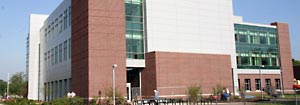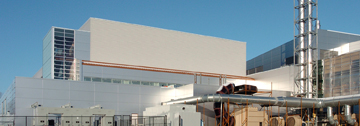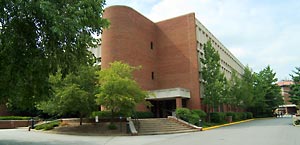Building Excitement
Strolling through Purdue's engineering mall, you see, and often hear, a building excitement. There's no doubt that Purdue is experiencing unprecedented growth, and Purdue Engineering is proud to share with you some of our accomplishments and exciting future plans in facility growth and renovation. We're investing in our people and facilities to bring renowned faculty to campus, to enhance the research and teaching of current faculty, and to create a peerless learning environment for our students.
Our research is growing in exciting ways as new faculty and laboratories make their impact. In May 2005, the College of Engineering extramural research cash awards were close to $6 million. (Not considering Agricultural and Biological Engineering and Computer Science.) This increases the year-to-date award total to almost $73 million, representing a 16% growth from last year's figures to date ($62.3 million). Our strategic goal is to double the College of Engineering research awards in five years.
Neil Armstrong Hall of Engineering

Completion Date: 2007
Assignable Sq. Ft.: 109,670 – Cost: $52 million
As the academic gateway to Purdue Engineering, Armstrong Hall is where many take their first step in their pursuit to become engineers. This facility houses Engineering Administration, Aeronautics and Astronautics, Engineering Projects in Community Service (EPICS), Engineering Education, Materials Engineering, the Minority Engineering Program, and the Women in Engineering Program.
Purdue leveraged $37.7 million in state funds to raise an additional $10 million in private gifts for the Armstrong project, including $2.5 million from Caterpillar, Inc., $1 million from Stephen Bechtel, Jr., $1 million from K.O. Johnson, and $1.9 million from Heddy Kurz.
Biomedical Engineering Building

Completion Date: 2006
Assignable Sq. Ft.: 53,844 – Cost: $25 million
The Biomedical Engineering Building, a four-level facility containing both undergraduate and graduate teaching and research facilities, is a first at any academic institution in Indiana. It will house the newly established Weldon School of Biomedical Engineering and provide a synergistic environment for all students, faculty, and staff within the school. Located in Purdue's Discovery Park, this building will link the school with many of the life science and nanotechnology initiatives occurring campus-wide.
Twelve million dollars of the building's cost is funded through private donations, including $5 million from the Whitaker Foundation, an independent foundation based in Arlington, Virginia. The foundation was established as a trust in 1975 to support research and education in biomedical engineering.
Birck Nanotechnology Center

Completion Date: 2005
Assignable Sq. Ft.: 105,245 – Cost: $58.3 million
This leading-edge national center located in Purdue's Discovery Park will, when complete, expand the frontiers of nanoscale research and be one of the most advanced facilities of its kind in the world, with specialized labs for nanoscale chemistry, biology, and physics; semiconductor-grade clean rooms; and office space for faculty, post-docs and graduate students from various disciplines across Purdue's campus.
A majority of this center's cost was covered by a $30 million contribution from Michael and Katherine Birck and a $10 million gift from Donald and Carol Scifres. The Lilly Foundation contributed $9 million.
Forney Hall of Chemical Engineering

Completion Date: Dedicated in 2004, occupancy began Jan. 2005
Assignable Sq. Ft.: 44,687 (new addition) – Cost: $19.5 million
Forney Hall's five-story addition and remodeling of the current building has transformed this 1940's structure into a 21st century learning and research environment equipped with state-of-the-art technologies and high-performance instrumentation. The new addition includes a 200-seat auditorium and two 60-seat classrooms, a unique fundamentals laboratory for hands-on undergraduate learning, an advanced laboratory for student research, and new labs for bioengineering, catalysis, and nanoscience research.
The addition to Forney Hall was paid for entirely with private donations, including $10 million from Robert and Marilyn Forney, both of whom are 1947 chemical engineering Purdue alumni, and $2 million from the Dow Chemical Company.
The Robert & Terry Bowen Civil Engineering Laboratory for Large Scale Research

Completion Date: 2003
Assignable Sq. Ft.: 57,641 – Cost: $11 million
Bowen Lab gets its muscle from the lab's strong floor and a 40-foot L-shaped strong wall that provides the capacity to test full-scale buildings up to four stories tall. With a clear ceiling height of 54 feet, loading apparatus, and advanced instrumentation, Bowen Lab is setting a new standard for materials and structures testing.
The A. A. Potter Engineering Center is a multi-purpose teaching and research facility administered by the Institute for Interdisciplinary Engineering Studies. Its mission is to develop and promote innovative technologies in response to society's needs. Its goal is to enhance our quality of life. It was planned with the idea of flexibility – that interdisciplinary research programs could have flexible arrangements of an efficient "laboratory-office" unit that can be assembled and tailored specifically to meet a need, for a finite time period.

